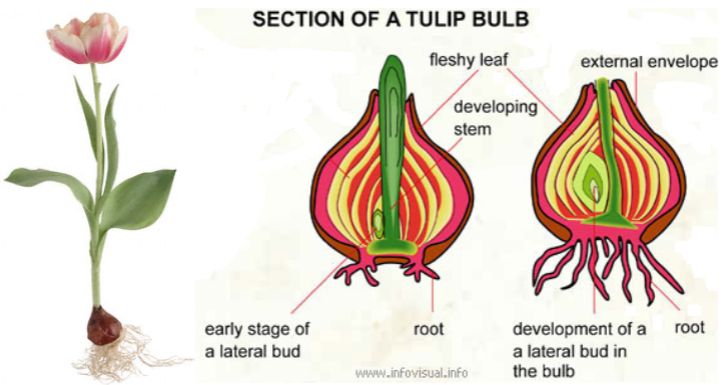5.1: Plants Anatomy Protocol
- Page ID
- 25197
All flowering plants have the same general body plan: roots, stems, branches, leaves, flowers, and fruits. Complete the table below by describing the function for each plant part.
|
Plant Part |
Function |
|
Leaves |
|
|
Stems and Branches |
|
|
Flowers |
|
|
Fruits |
|
|
Roots |

Over the last 140-180 million years of angiosperm evolution, natural selection has resulted in many different variations on this basic form and not all of the parts are where you might expect them to be. For example, much of a tulip’s belowground energy storage is not in roots like most plants but in an underground stem surrounded by fleshy leaves, a bulb.

Humans began domesticating plants over 12,000 years ago. During domestication, plants (and animals) undergo evolution by selection as farmers choose which individuals in the population will reproduce. When this human preference is the environment that exerts a selective force on a population, we call this selection "artificial selection". By only allowing plants with traits we enjoy—like larger and sweeter fruits—to reproduce, humans, like nature, have caused many changes in plant form.
In today’s lab your goal is to identify which part (root, stem, leaf, flower, or fruit) of a domesticated plant we eat. Before you start it will be helpful to review the structure of flowers and the meaning of the word “fruit.”
Label the parts of a flower in the diagram shown below.

Which part of the flower becomes a fruit?
How can you tell if a plant organ is a fruit?
Sometimes, a plant organ that is biologically a fruit is called a “vegetable” in everyday English. This is because these fruits have lower amounts of the sugar fructose and are used in savory rather than sweet cooking. Can you think of two fruits that are called vegetables?
Your teacher will supply several foods and vegetables for you to examine. In the table below, record which part of the plant each of these is, what evidence you used to make that conclusion, and whether it is a fruit or a vegetable in everyday English. It will be helpful to refer to the figures and table on pages 1 and 2 and ask yourself, “How can I tell if this plant part is a root/stem/leaf etc.?” If you have conflicting evidence, what else would you need to know to make your decision?
|
Name |
Plant Part |
Evidence/Further information |
Is this called a fruit or vegetable in everyday English? |

